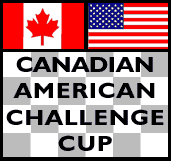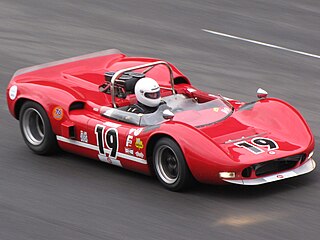Related Research Articles

The Chevrolet Corvette is a line of American two-door, two-seater sports cars manufactured and marketed by General Motors under the Chevrolet marque since 1953.
March Engineering was a Formula One constructor and manufacturer of customer racing cars from the United Kingdom. Although only moderately successful in Grand Prix competition, March racing cars enjoyed much better success in other categories of competition, including Formula Two, Formula Three, IndyCar and IMSA GTP sportscar racing.

The Canadian-American Challenge Cup, or Can-Am, was an SCCA/CASC sports car racing series from 1966 to 1974, and again from 1977 to 1987.

Formula 5000 was an open wheel, single seater auto-racing formula that ran in different series in various regions around the world from 1968 to 1982. It was originally intended as a low-cost series aimed at open-wheel racing cars that no longer fit into any particular formula. The '5000' denomination comes from the maximum 5.0 litre engine capacity allowed in the cars, although many cars ran with smaller engines. Manufacturers included McLaren, Eagle, March, Lola, Lotus, Elfin, Matich and Chevron.
Chaparral Cars was a pioneering American automobile racing team and race car developer that engineered, built, and raced cars from 1963 through 1970. Founded in 1962 by American Formula One racers Hap Sharp and Jim Hall, it was named after the roadrunner, a fast-running ground cuckoo also known as a chaparral bird.

Team Penske is an American professional auto racing organization, competing in the IndyCar Series, NASCAR Cup Series, IMSA SportsCar Championship and FIA World Endurance Championship. Debuting at the 1966 24 Hours of Daytona, the organization has also competed in various other types of professional racing such as Formula One, Can-Am, Trans Am, and Australia's Supercars Championship. Altogether, Team Penske has earned over 500 victories and over 40 championships in all of auto racing. Team Penske is a division of Penske Corporation, and is owned and chaired by Roger Penske. The team president is Tim Cindric.

A Daytona Prototype was a type of sports prototype racing car developed specifically for the Grand American Road Racing Association's Rolex Sports Car Series as their top class of car, which replaced their main prototype racing class, specifically Le Mans Prototypes (LMPs). The cars later competed in the merged series of the IMSA SportsCar Championship, from 2014 to 2016, before being phased out and replaced by the Daytona Prototype International class in 2017. They are named after the main series event, the Rolex 24 at Daytona.

The Chaparral 2F is a Group 6 sports prototype designed by Jim Hall and Hap Sharp and built under their company Chaparral Cars. Built with the intention to compete in the World Sportscar Championship, it competed in the 1967 season, with a best finish of first at the BOAC 500, driven by Phil Hill and Mike Spence. The 2F, alongside its Can-Am sibling the 2E, had a heavy influence in dictating the direction of Formula One car design in the late 1960s and early 1970s. With the amounts of mechanical grip the car and tires could provide approaching their respective limits, there was a larger emphasis on aerodynamic efficiency with race car designer Colin Chapman quick to include them on his Formula One cars.

Truesports was an automobile racing team founded by Jim Trueman based in Hilliard, Ohio. The team is best known for winning the 1986 Indianapolis 500 and back-to-back CART championships in 1986 and 1987. The team won 19 points-paying Indy car races.

The McLaren M6A was a Group 7 prototype race car designed and developed by driver Bruce McLaren, and built by his Bruce McLaren Motor Racing team for their entry in 1967 Can-Am season. As a replacement for the team's M1Bs from 1966, the Chevrolet-powered M6A's improved design earned Bruce McLaren and his team their first of multiple Can-Am championships. After the M6As were replaced by the M8A in preparation for 1968, McLaren and technical partner Trojan–Tauranac Racing developed the M6B which was sold to customers for use in Can-Am as well as other racing series.
The 1977 Can Am season was the tenth running of the Sports Car Club of America's prototype-based series. Despite the revived name, however, the new series was entirely unrelated to the previous series which had folded in 1974. Most of the competitive cars were based on Formula 5000 chassis. Also, the first time under 2-litre cars were allowed to race, but with no separate class. Patrick Tambay was declared champion, winning six of the nine races that year for Carl Haas. While Lola chassis dominated the series, a Chevrolet powered Schkee DB1 driven by Tom Klausler won the first race at Mont Tremblant. Other competitive cars included the 1974 champions Shadow, who now used Dodge engines and Wolf with a Dallara-built chassis. While Chevrolet was not the only engine supplier, they swept the entire season. This season also marked a resurgence of interest in SCCA events, with Can Am accompanying F5000 and the Trans Am Series seeing a mild resurgence in the eighties.
The 1980 Can Am Series season was the thirteenth running of the Sports Car Club of America's prototype based series and the fourth running of the revived series. Patrick Tambay was declared champion, winning six of the ten rounds and finishing third at Riverside. Chevrolet again swept the season. Lola, Holbert, and Prophet were the dominant chassis suppliers, with Intrepid finishing second at Watkins Glen and Frisbee finishing first at Laguna Seca.
The 1981 Can Am series season was the fourteenth running of the Sports Car Club of America's prototype-based series, and the fifth running of the revived series. Geoff Brabham was declared champion, despite only winning two races. Chevrolet again dominated the season. The dominant chassis manufacturers were March, Lola, Holbert, Frissbee, and VDS. IndyCar drivers Al Unser and Bobby Rahal also podiumed at Road America and Mosport, respectively.
The 1983 Can Am season was the sixteenth running of the Sports Car Club of America's prototype series and the seventh of the revived series. 1983 marked the second year of Chevrolet having major competition, with Cosworth taking second at Mosport, first at Lime Rock, second at Trois-Rivières, first at the second race at Mosport, and second at Sears Point. Hart would take third at Lime Rock and third at Trois-Rivières. Porsche would get its first podiums this season, with a win at Road America and third at the second race at Mosport. The dominant chassis were Frissbee, Ensign, Lola, VDS, Scandia, and Ralt. Jacques Villeneuve, Sr. was declared champion, with podiums in almost every race. He would, however, become the final major racecar driver to win a Can Am championship.
The 1984 Can Am season was the seventeenth running of the Sports Car Club of America's prototype series, and the eighth running of the revived series. 1984 would mark a major downturn in the series, as Juan Manuel Fangio II would become the last major driver to podium in a Can Am Series race, finishing third at Dallas. The dominant manufacturers were Chevrolet, Hart, BMW for the first time with a third-place finish at Brainerd, Cosworth, Lola, Ralt, and March. Dominant chassis were VDS, March, Frissbee-Lola, Ralt, and Williams with their first podium with a third-place finish at Lime Rock. Michael Roe was declared champion, with seven wins. The final race at Green Valley would feature the final truly notable driver in series history, John Andretti.

The Dallara DW12 is an open-wheel formula racing car developed and produced by Italian manufacturer Dallara for use in the IndyCar Series. It replaced the aging Dallara IR-05 chassis in the 2012 IndyCar Series season and is to be used through the 2026 season, after which it is to be replaced by the planned Dallara IR-27.

The McLaren M8A was a race car developed by driver Bruce McLaren and his Bruce McLaren Motor Racing team for their entry in 1968 Can-Am season. The M8A and its successors dominated Can-Am racing for four consecutive Can-Am seasons, until the arrival of the Porsche 917.
The Lola T530 is a purpose-built Can-Am sports prototype, designed by British manufacturer Lola Cars in for the revived Can-Am series 1980. It was very successful, winning 7 of the 9 races in its first season of competition alone, and gave Patrick Tambay the championship with Carl A. Haas racing Team. Geoff Brabham won the championship in 1981; despite only winning 2 races. It was used in Can-Am racing until 1983. It was later used in the international Interserie racing series, and the British Thundersports racing series, between 1984 and 1988. Between 1980 and 1988, it scored a total of 32 race wins, and 43 podium finishes; a very impressive tally indeed. As with all other full-size Can-Am cars of the time, it used a mid-mounted 5-liter, naturally-aspirated, Chevrolet V8 engine. A total of 10 chassis' were built.
The Cooper T90 was a Formula 5000 racing car built by the British racing team Cooper in 1969.

The McLaren M1A, and its derivatives, the McLaren M1B and the McLaren M1C, are a series of mid-engined Group 7 sports prototype race cars built by McLaren, between 1963 and 1968.
References
- ↑ "Can-Am 1984".
- ↑ "March 847" . Retrieved 20 June 2022.
- ↑ "Bonhams : 1984 March-Chevrolet 847 CANAM single-seater Chassis no. 847/02".
- ↑ "Single-Seat RK March 847 Can-Am". 14 November 2011.
- ↑ "March 847" . Retrieved 20 June 2022.
- ↑ Brown, Allen. "Can-Am 1984 « OldRacingCars.com". OldRacingCars.com.
- ↑ "The second-generation Can-Am racers that took the UK by storm". 14 January 2022.
- ↑ "SVRA Group 7" (PDF). Retrieved 20 June 2022.